PAINTING: In the first hour, we will look at a number of portraits, from 1976 back to 1501, to try to
establish some criteria for discussion. I have already posted the two slides below on the website; do think about them. I will be
adding some related materials when we discuss them in class. rb.

Some questions: What is the approximate age of the two sitters? Does this affect the approach taken by each artist? Which painting seems the most posed, the most self-aware? Where is each character in relation to the picture plane? Both are wearing expensive clothes; how does each artist manage the details? Does either picture imply action or movement? Which portrait took the most time to paint? Which makes you most conscious of the skill of the artist?
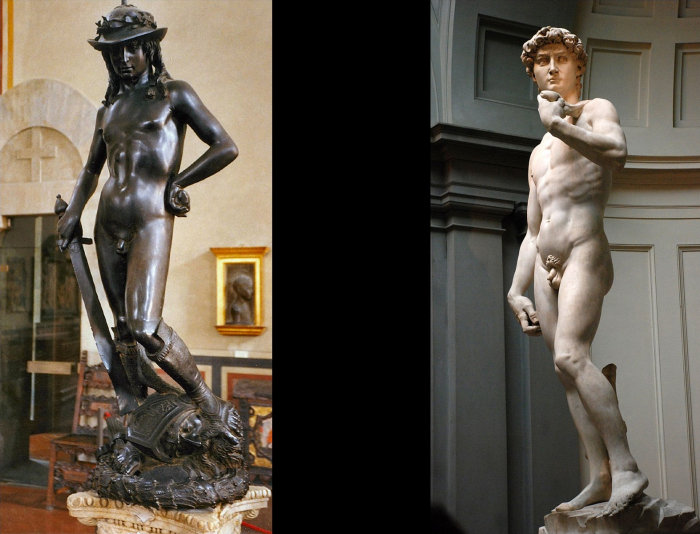
Some questions: How would you describe the setting in each picture? What does each artist intend to convey by his choices? Are there any details in either picture that seem random or casual? Given the relevant changes in fashion, are both dresses in the same key, as it were? Both hairstyles? Why did the artist choose the pose with one hand under the chin? What is the effect of the mirror in the Ingres? Which seems the more intimate?
FILM: In the second hour, we will look at the portrayal of some iconic figures by different screen actors: Abraham Lincoln, Princess Diana, and (if time) Truman Capote. Although I will show more intimate clips in class, you can warm up in the meantime with these two renditions of the Gettysburg Address:
Gregory Peck in The Blue and the Gray (1982)
Tom Amandes in Saving Lincoln (2013)
PEOPLE: Here are brief bios of the artists and poets we shall consider in the class, listed in order of birth. You can access all biographies via the BIOS link on the syllabus page.
 |
Giovanni Bellini, 1435–1516. Venetian painter. One of a family of artists, he more than anyone was responsible for developing the characteristic Venetian style of painting in layers of oils, no doubt learned from the Flemish masters. This gives his pictures their extraordinary light, whether portraits or religious subjects. |
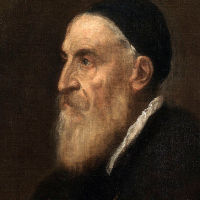 |
Tiziano Vecellio (Titian), 1485–1576. Venetian painter. Arguably the greatest Venetian painter of the High Renaissance, he produced works in just about every genre over an exceptionally long career. Probably his greatest influence was in his handling of paint and use of color, which became a starting point for Rubens and others in the next century. |
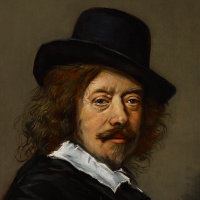 |
Frans Hals, 1582–1666. Dutch painter. Though born in Antwerp, he moved to Harlem with his parents and spent the rest of his life there. 24 years older than Rembrandt, he was the first great master of the Dutch Golden Age and its leading portraitist. His style is remarkable for the effects he could achieve from a few swift touches of paint. |
 |
Rembrandt Harmenzoon van Rijn, 1606–69. Dutch painter and printmaker. The greatest artist of the Dutch Golden Age, he nonetheless retained his own style which set him apart from his contemporaries. There is a strong baroque influence earlier in his career, but his later work developed a quality of deep introspection in which the subject seems to glow within rich layers of paint. |
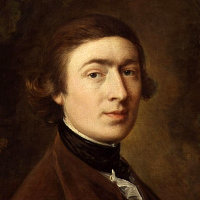 |
Thomas Gainsborough, 1727–88. English painter. He became the dominant English portrait painter in the second half of the 18th century, but also produced numerous independent landscapes for his own pleasure. In 1768, he became a foundation member of the new Royal Academy. |
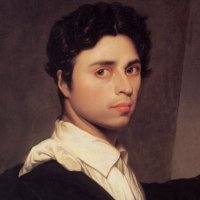 |
Jean-Dominique Ingres, 1780–1867. French painter. Ingres was trained in the academic tradition, and although one of the great masters of French Romantic era, his style was always marked by a cool classicism and precision of line, in contrast to the freer handling of paint by his contemporary Delacroix. |
 |
Gustave Courtois, 1852–1923. French painter. Courtois was a late 19th-century painter in the French academic tradition, known for his portraits and genre scenes. |
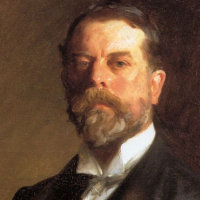 |
John Singer Sargent, 1856–1925. American painter. Sargent was born in Florence, the son of wealthy cultured parents, and much of his career was spent in Europe, although his rising fame as the preeminent society portraitist of his day also took him back to America. He is said to have hated portraiture, though, and diversified into landscapes and watercolors for his own satisfaction. |
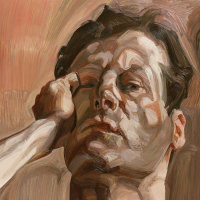 |
Lucian Freud, 1922–2011. German-English painter. Born in Berlin, the grandson of Sigmund Freud, Lucian came to Britain in 1931 with his parents and became a British citizen in 1939. One of the leading representational painters in postwar Britain, he was also her leading portraitist, albeit in an uncompromising and less traditional style. |
| NOTE TO THOSE REDIRECTED FROM ELSEWHERE: I based this particular course on the discussion of paired examples: art in the first hour, and other media (in this case film) in the second. You can reproduce the experience to some extent by clicking on any of the images with a star in the corner; this will reveal larger-scale versions of the separate works. Generally, these were shown without the artists' names or titles. After the class had discussed some of the questions below each comparison, I would offer a few facts; you can reveal these yourselves by using the "click to reveal" link. rb. |
ART: The paintings discussed (or intended to be discussed) in the first hour of class are below. For materials relevant to the second hour, click here.
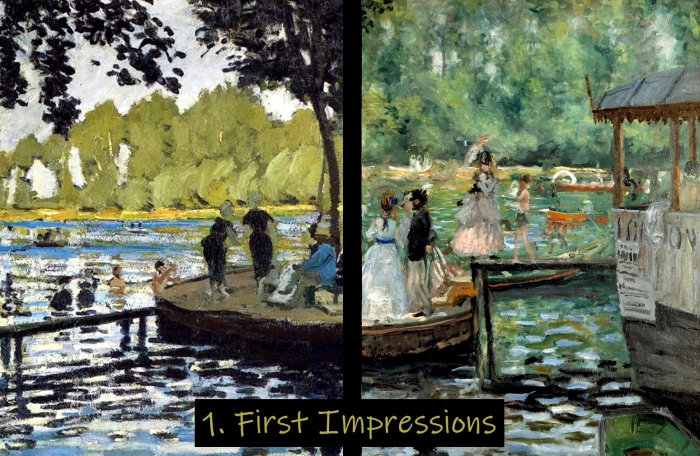
Title slide (Frank Auerbach with Lucian Freud portrait)

Lucian Freud: Frank Auerbach (1976)
Some questions: What qualities of the sitter's face does the painter concentrate on the most? How does this translate into personality? What can you understand of the relationship between artist and sitter? Is this a portrait you would want in the National Portrait Gallery?
Some facts: Click to reveal. randson of Sigmund Freud) and Auerbach were born in Germany, then fled to England with their families to escape the Nazis. Although a decade apart in age, the two artists, both of whom practiced a bold kind of figurative painting, became close friends.
Some facts: Both Freud (the grandson of Sigmund Freud) and Auerbach were born in Germany, then fled to England with their families to escape the Nazis. Although a decade apart in age, the two artists, both of whom practiced a bold kind of figurative painting, became close friends.
COMPARISON 1



Some questions: Both sitters are dressed up; what do they intend their choice of clothes to say? Is there any difference in the nature of the public faces they are putting on? What does each portrait suggest of the private individual?
Some facts: Click to reveal. he left is of Henry James, commissioned by a group of subscribers to celebrate the novelist's 70th birthday; James pronouced the picture perfect; ultimately Sargent, a fellow American in Europe, waived his fee. The one on the right, from seven years earlier, is a self-portrait—but unlike many other artists, Sargent seldom painted himself for practice; this painting was commissioned by the Uffizi Gallery in Florence, an honor that Sargent took very seriously.
Some facts: The portrait on the left is of Henry James, commissioned by a group of subscribers to celebrate the novelist's 70th birthday; James pronouced the picture perfect; ultimately Sargent, a fellow American in Europe, waived his fee. The one on the right, from seven years earlier, is a self-portrait—but unlike many other artists, Sargent seldom painted himself for practice; this painting was commissioned by the Uffizi Gallery in Florence, an honor that Sargent took very seriously.
COMPARISON 2



Some questions: Why does each artist choose to paint the sitter in profile? What image is he (or she) meaning to convey? Why did each artist (or the sitter) choose that particular dress? Does either painting imply movement? What does the table in the Sargent do? Which do you think might have pleased the public more?
Some facts: Click to reveal. areer, Sargent painted society portraits on commission, but on this occasion he asked the sitter, a well-known Parisian socialite, whether he might paint her, no doubt hoping to make his reputation (and cement hers) by a great success at the Salon. Even though the subject was anonymous (Portrait of Madame X), the public recognized the sitter, and the suggestive pose reinforced her gossip reputation for infidelity. It was a humiliation for both, and Sargent was forced to leave Paris for London. The Courtois painting seven years later, though, met with no such criticism.
Some facts: For most of his career, Sargent painted society portraits on commission, but on this occasion he asked the sitter, a well-known Parisian socialite, whether he might paint her, no doubt hoping to make his reputation (and cement hers) by a great success at the Salon. Even though the subject was anonymous (Portrait of Madame X), the public recognized the sitter, and the suggestive pose reinforced her gossip reputation for infidelity. It was a humiliation for both, and Sargent was forced to leave Paris for London. The Courtois painting seven years later, though, met with no such criticism.
COMPARISON 3



Some questions: How would you describe the setting in each picture? What does each artist intend to convey by his choices? Are there any details in either picture that seem random or casual? Given the relevant changes in fashion, are both dresses in the same key, as it were? Both hairstyles? Why did the artist choose the pose with one hand under the chin? What is the effect of the mirror in the Ingres? Which seems the more intimate?
Some facts: Click to reveal. nsborough's sitter, was the eldest daughter of the Lord Mayor of London and granddaughter of the Earl of Oxford. This is the second portrait he painted of her, following another in an exterior setting, probably on the occasion of her marriage to George Drummond (see below). Louise de Broglie, Comtesse d'Haussonville, came from an old and wealthy artistocratic family. But she was no mere socialite; in later years, she had considerable independent success as a biographer and novelist. Ingres worked for several years on the portrait, interrupted by his sitter's pregnancy, making several sketches in which he tried out small changes in the pose. He still felt he had not done justice to the beauty of his sitter.
Some facts: Mrs Drummond, Gainsborough's sitter, was the eldest daughter of the Lord Mayor of London and granddaughter of the Earl of Oxford. This is the second portrait he painted of her, following another in an exterior setting, probably on the occasion of her marriage to George Drummond (see below). Louise de Broglie, Comtesse d'Haussonville, came from an old and wealthy artistocratic family. But she was no mere socialite; in later years, she had considerable independent success as a biographer and novelist. Ingres worked for several years on the portrait, interrupted by his sitter's pregnancy, making several sketches in which he tried out small changes in the pose. He still felt he had not done justice to the beauty of his sitter.

Gainsborough: Mrs Drummond, with 1798 version (1779, Montreal)
Some questions: What is the difference in effect between the interior and exterior settings? Which conveys more about the sitter as a person? Which speaks more to status?

Ingres: Comtesse d'Haussonville, with sketches
Some questions: What is the difference in effect between the three poses? Is it deliberate that the face in the black and white one is slightly different from the other two? Is the dress in the beige drawing merely a stand-in for the one she would eventually wear, or has Ingres chosen it for a specific effect?
COMPARISON 4



Some questions: What is the approximate age of the two sitters? Does this affect the approach taken by each artist? Which painting seems the most posed, the most self-aware? Where is each character in relation to the picture plane? Both are wearing obviously expensive clothes; how does each artist manage the details? Does either picture imply action or movement? Which portrait took the most time to paint? Which makes you most concious of the skill of the artist?
Some facts: Click to reveal. ds on the shield in the background of the Hals refers to the family name, literally "Cow Man." Willem was the eldest son of the family, in his early twenties. Hals also painted his parents in a much more sober style (see below); the portrait of his mother is in the Baltimore Museum of Art. The Jan Six portrait (1654) is one of the few Rembrandt masterpieces to have remained in the family of its original subject; you have to go by appointment to the Six House in Amsterdam to see it. It is unusual too in that Six is not seen sitting for his portrait, nor in some contrived dramatic action, but quietly pulling on his gloves as he gets ready to go out to work. It is the same principle as Rembrandt would use later in his great group portrait of the Syndics of the Cloth Hall (1662, see below).
Some facts: The three cow heads on the shield in the background of the Hals refers to the family name, literally "Cow Man." Willem was the eldest son of the family, in his early twenties. Hals also painted his parents in a much more sober style (see below); the portrait of his mother is in the Baltimore Museum of Art. The Jan Six portrait (1654) is one of the few Rembrandt masterpieces to have remained in the family of its original subject; you have to go by appointment to the Six House in Amsterdam to see it. It is unusual too in that Six is not seen sitting for his portrait, nor in some contrived dramatic action, but quietly pulling on his gloves as he gets ready to go out to work. It is the same principle as Rembrandt would use later in his great group portrait of the Syndics of the Cloth Hall (1662, see below).

Frans Hals: portraits of Willem Coymans and his parents

Rembrandt: The Syndics of the Cloth Hall (1662, Rijksmuseum)
COMPARISON 5



Some questions: What is the function of the clothing in each picture? Which has the more detail? Both use the convention of a stone sill to justify cutting off the figure at chest height; how has each artist treated it? How is the sense of depth created in each picture? What can you guess about the commission in each case? Which has the more character?
Some facts: Click to reveal. is shown in his official robes as Doge of Venice; this is an official portrait and Bellini has been meticulous in recording every detail. There is no general agreement as to the identity of Titian's sitter; theories have included Ariosto and Titian himself; the National Gallery now suggest he may have been a member of the Barbarigo family, who also supplied Venice with two Doges. In 1640, Rembrandt copied Titian's pose for a self-portrait of his own.
Some facts: Leonardo Loredan is shown in his official robes as Doge of Venice; this is an official portrait and Bellini has been meticulous in recording every detail. There is no general agreement as to the identity of Titian's sitter; theories have included Ariosto and Titian himself; the National Gallery now suggest he may have been a member of the Barbarigo family, who also supplied Venice with two Doges. In 1640, Rembrandt copied Titian's pose for a self-portrait of his own.
BOOK: I have just come across the book Portraiture by Shearer West in the excellent Oxford History of Art series. It is a very good choice as an introduction to the subject, thematic rather than chronological, and with some quite surprising points about portraiture in the modern era. The link takes you to the Amazon page; it is about $30.
FILM: Most of the clips shown or planned for the class are available on YouTube, though some
are of a different length, and most do not have titles. The one I can't find is the clip from The Crown, though we do
have the scene just before the one we watched, containing some iconic flashbacks, and there is also a quite interesting
comparison reel with clips of Emma Corrin and Kristen Stewart set side by side. The script for the second hour is available
here.
Gregory Peck in The Blue and the Gray (1982)
Tom Amandes in Saving Lincoln (2013)
Walter Huston in Abraham Lincoln (Griffith, 1930)
Daniel Day-Lewis in Lincoln (Spielberg, 20120)
Kristen Stewart in Spencer (Larraín, 2021)
Emma Corrin in The Crown (Season 4, 2020)
Emma Corrin and Kristen Stewart compared
Toby Jones in Infamous (McGrath, 2006)
Philip Seymour Hoffman in Capote (Miller, 2005)
PEOPLE: Here are brief bios of the artists considered in the class, in order of birth.
You can access all biographies via the BIOS link on the syllabus page.
 |
Giovanni Bellini, 1435–1516. Venetian painter. One of a family of artists, he more than anyone was responsible for developing the characteristic Venetian style of painting in layers of oils, no doubt learned from the Flemish masters. This gives his pictures their extraordinary light, whether portraits or religious subjects. |
 |
Tiziano Vecellio (Titian), 1485–1576. Venetian painter. Arguably the greatest Venetian painter of the High Renaissance, he produced works in just about every genre over an exceptionally long career. Probably his greatest influence was in his handling of paint and use of color, which became a starting point for Rubens and others in the next century. |
 |
Frans Hals, 1582–1666. Dutch painter. Though born in Antwerp, he moved to Harlem with his parents and spent the rest of his life there. 24 years older than Rembrandt, he was the first great master of the Dutch Golden Age and its leading portraitist. His style is remarkable for the effects he could achieve from a few swift touches of paint. |
 |
Rembrandt Harmenzoon van Rijn, 1606–69. Dutch painter and printmaker. The greatest artist of the Dutch Golden Age, he nonetheless retained his own style which set him apart from his contemporaries. There is a strong baroque influence earlier in his career, but his later work developed a quality of deep introspection in which the subject seems to glow within rich layers of paint. |
 |
Thomas Gainsborough, 1727–88. English painter. He became the dominant English portrait painter in the second half of the 18th century, but also produced numerous independent landscapes for his own pleasure. In 1768, he became a foundation member of the new Royal Academy. |
 |
Jean-Dominique Ingres, 1780–1867. French painter. Ingres was trained in the academic tradition, and although one of the great masters of French Romantic era, his style was always marked by a cool classicism and precision of line, in contrast to the freer handling of paint by his contemporary Delacroix. |
 |
Gustave Courtois, 1852–1923. French painter. Courtois was a late 19th-century painter in the French academic tradition, known for his portraits and genre scenes. |
 |
John Singer Sargent, 1856–1925. American painter. Sargent was born in Florence, the son of wealthy cultured parents, and much of his career was spent in Europe, although his rising fame as the preeminent society portraitist of his day also took him back to America. He is said to have hated portraiture, though, and diversified into landscapes and watercolors for his own satisfaction. |
 |
Lucian Freud, 1922–2011. German-English painter. Born in Berlin, the grandson of Sigmund Freud, Lucian came to Britain in 1931 with his parents and became a British citizen in 1939. One of the leading representational painters in postwar Britain, he was also her leading portraitist, albeit in an uncompromising and less traditional style. |
